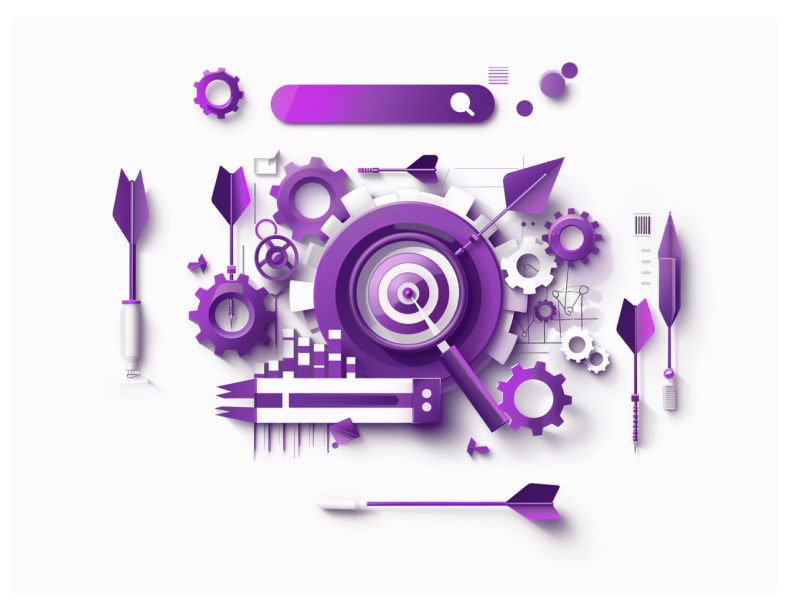Enterprises invest billions generative AI
With billions of dollars flowing into the AI sector, companies are aiming to leverage AI’s potential to create new applications and improve existing processes. Growing investments have targeted a wide range of applications, from chatbots that support customer service to sophisticated search tools that optimize information retrieval.
For instance, Microsoft, Google, and Amazon are leading the charge by allocating large portions of their R&D budgets to generative AI projects. According to IDC, global spending on AI systems is expected to reach $110 billion by 2024, pointing out a compound annual growth rate (CAGR) of 20.1% from 2021.
Billions flow into chatbots and search tools for AI
Chatbots, powered by generative AI, improve customer interactions through personalized and timely responses – reducing wait times and boosting customer satisfaction.
Companies like Bank of America and Starbucks are integrating AI-driven chatbots to streamline customer service and boost engagement.
Search tools use generative AI to deliver more accurate and relevant search results, which is particularly valuable in e-commerce, healthcare, and finance, wherein quick access to precise information is a must. For instance, Shopify has invested heavily in AI-driven search capabilities to help merchants and customers find products more efficiently, leading to increased sales and customer loyalty.
The real challenge: From AI commitment to production
While enterprises are eager to invest in AI technologies, deploying these systems into operational environments is still a complex challenge. Traditional software development methods, which rely on deterministic processes, often fall short in addressing the intricacies of AI deployment.
Unlike conventional software, AI systems operate on probabilistic outcomes, introducing variability and unpredictability into development cycles. This complexity has sparked a shift in how businesses approach software development and quality assurance for AI applications.
McKinsey reports that only about 20% of AI-aware companies have incorporated AI into their core business processes, indicating a gap between awareness and effective implementation.
Gaps in AI commitment to production
Traditional software development practices, characterized by a deterministic approach, are insufficient for the dynamic nature of AI. In a deterministic framework, developers follow a linear, predictable path with clear steps for testing and iteration. This works well for conventional applications but is inadequate for AI systems that require constant learning and adaptation.
Generative AI introduces a host of variables at every stage, from model selection and data quality to user input and contextual understanding – making it difficult to guarantee consistent performance and reliability.
Companies often face challenges in maintaining the quality, safety, and performance of their AI applications, and according to Gartner, only 53% of AI projects make it from prototype to production.
Capitalizing on the chaos: AI’s non-deterministic development
As already stated, AI development introduces a non-deterministic paradigm, where outcomes cannot be precisely predicted, creating a complex environment for developers who must manage loads of variables simultaneously. Generative AI applications depend on dozens of factors, including the quality of training data, the effectiveness of algorithms, and the context of user interactions.
For example, a customer service chatbot must understand and respond appropriately to a wide range of queries. The chatbot’s performance depends on its ability to interpret language nuances, user intent, and contextual information. Managing these moving parts requires a comprehensive and detailed framework for monitoring and evaluation.
Mainstream approaches to AI evaluation
Two mainstream approaches are typically employed: hiring specialized talent to manage the complexities or building internal tools independently. Both strategies, while common, come with their own set of challenges and costs.
Managing AI variables with expert talent
Hiring talent brings in AI experts who can oversee and manage the moving parts involved in AI development – with a focus on maintaining the quality, safety, and performance of AI models. They continuously tweak models, ensure data quality, and refine user interaction parameters to keep the AI applications functioning optimally.
This often results in increased financial overheads. Salaries for AI experts can be exorbitant, with experienced professionals commanding six-figure incomes. For instance, data from Glassdoor indicates that the average salary for an AI engineer in the United States is around $114,000 per year, with top professionals earning much more. The cost of onboarding, training, and retaining these specialists must also be considered, which further strains the budget.
DIY tooling: The high-cost route
Companies can develop their own set of tools and frameworks to manage evaluating their AI models – typically involving large investment in time and resources, as internal teams need to create, test, and maintain these tools.
In turn, this diverts focus from core business activities and can delay other critical projects. Research by McKinsey shows that only about 20% of AI projects actually make it into production, partly due to the extensive resource allocation required for internal tooling development. To add to this, maintaining these custom tools requires ongoing attention, adding to the operational burden.
The four components of Maxim’s AI evaluation
Maxim’s platform is built on four core components: the Experimentation Suite, the Evaluation Toolkit, Observability, and the Data Engine. Each component is key in expertly managing the AI application lifecycle.
1. Experiment freely with Maxim’s suite of tools
The Experimentation Suite provides an environment for teams to iterate and test different aspects of their AI models, including a prompt content management system (CMS), an integrated development environment (IDE), a visual workflow builder, and connectors to external data sources and functions.
Teams can experiment with different prompts, models, and parameters to determine the best configurations for their specific use cases, which aids in accelerating the development process and helps identify optimal solutions quickly.
2. Comprehensive evaluation
Maxim’s Evaluation Toolkit provides a unified framework for both AI-driven and human-driven evaluation – enabling teams to quantitatively assess improvements or regressions in their applications using large test suites.
The toolkit visualizes evaluation results on dashboards, covering important aspects such as tone, faithfulness, toxicity, and relevance, helping teams make informed decisions about model adjustments and improvements.
3. Stay ahead with real-time AI observability
The Observability component lets users track real-time production logs and run automated online evaluations to detect and debug live issues. Through monitoring quality, safety, and performance signals such as toxicity, bias, hallucinations, and jailbreaks, the platform helps maintain the expected level of quality.
Users can set real-time alerts to notify them about any regressions in performance, cost, or quality metrics, which then helps resolve issues more quickly.
4. Expertly leverage your data with Maxim’s engine
The Data Engine is designed to improve and optimize datasets based on insights gathered from the observability suite, curating and enriching data for fine-tuning and continuous AI model improvement. This makes sure that the AI systems stay accurate and reliable over time, adapting to new data and changing conditions.
How Maxim accelerates AI deployment
Maxim’s platform dramatically accelerates the deployment of AI products, claiming to improve deployment speed by five times for its early partners. Integrating tools for prompt engineering, model testing, and real-time monitoring has helped Maxim reduce the length of the development cycle.
Early partners report that they have been able to iterate quickly, troubleshoot efficiently, and bring their AI solutions to market faster than traditional methods allowed.
For example, a typical AI development cycle involves extensive testing and validation phases, which can stretch for months. With Maxim, this process is streamlined through automated evaluations and real-time feedback loops, cutting down on manual interventions and accelerating time-to-market.
Automated control over quality, safety, and security
Maxim’s platform offers automated quality controls, focusing on key aspects such as toxicity, bias, hallucinations, and jailbreaks. It’s particularly beneficial for maintaining the integrity and reliability of AI applications. Maxim helps businesses avoid potential pitfalls that could arise from AI models generating harmful or biased outputs.
Real-time alerts for performance, cost, and quality regressions
Maxim’s real-time alert system monitors performance metrics, cost implications, and quality indicators, notifying users of any regressions. For instance, if an AI model’s latency increases unexpectedly or if the cost per transaction rises above a set threshold, the system immediately alerts the relevant team members.
Who’s benefiting most from Maxim’s innovations?
B2B, Gen AI, BFSI, and Edtech
Maxim targets several key domains where AI evaluation is particularly challenging and essential, including B2B technology, generative AI services, banking, financial services, and insurance (BFSI), as well as educational technology (Edtech).
- B2B technology: Companies in this sector leverage AI to optimize operations, improve customer interactions, and develop innovative products.
- Generative AI services: Businesses providing AI-driven services benefit from improved model reliability and performance.
- BFSI: Financial institutions require stringent AI evaluation to comply with regulatory standards and to protect sensitive data.
- Edtech: Educational platforms use AI for personalized learning experiences, requiring precise and bias-free algorithms.
Features tailored for enterprises
Maxim provides a suite of specialized tools designed to meet the complex needs of enterprise clients, including:
- Role-based access controls: Makes sure that only authorized personnel can access and modify AI models, improving security and compliance.
- Compliance and collaboration tools: Facilitates adherence to industry regulations and promotes seamless teamwork across departments.
- Virtual private cloud deployment options: Provides a secure and isolated environment for deploying AI solutions, meeting the stringent security requirements that enterprise clients typically enforce.
How Maxim holds up against Dynatrace and Datadog
Maxim competes with well-funded companies like Dynatrace and Datadog, which are known for their performance monitoring and observability solutions. While these competitors focus on specific phases of AI development, Maxim sets itself apart by offering an integrated, end-to-end solution that simplifies the AI development process through providing all necessary tools within a single platform.
Final thoughts
Business decision makers must carefully consider the transformative impact of streamlined AI evaluation on their organization’s agility and innovation. Comprehensive evaluation tools like Maxim can greatly reduce development time, improve the quality of AI deployments, and boost overall operational efficiency.
In competitive markets, accelerating your time-to-market while making sure that AI solutions are robust and reliable, are keys to positioning your company as innovative industry leaders.





